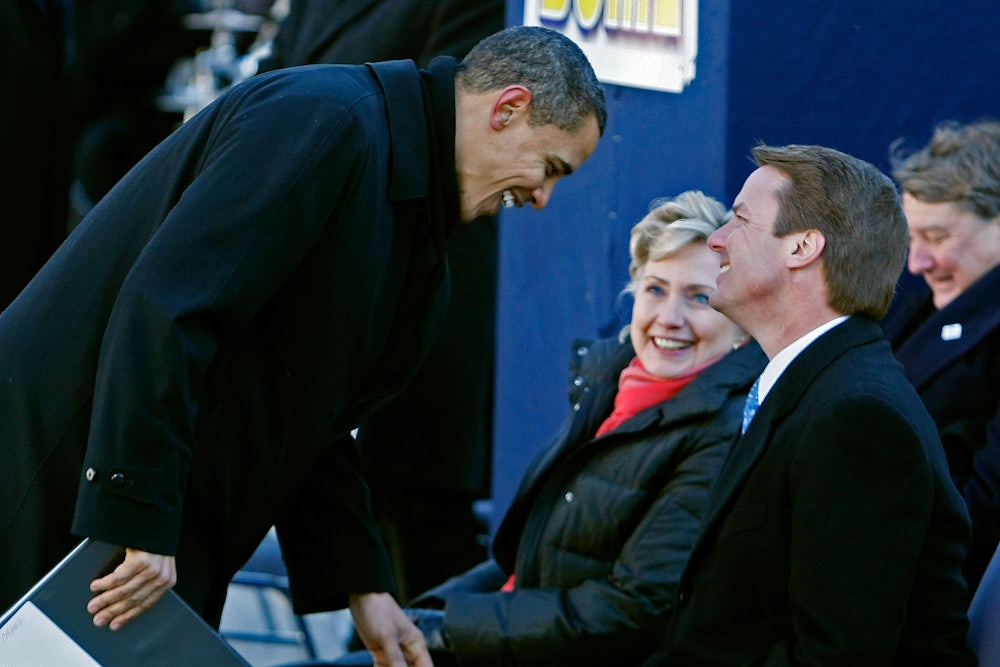Donald Trump claims he has finally repealed Obamacare through the Republican tax bill. “The individual mandate is being repealed,” he told a cabinet meeting in December. “When the individual mandate is being repealed, that means Obamacare is being repealed.” He has since tweeted that the tax bill “essentially Repeals (over time) ObamaCare.”
He’s wrong—Obamacare’s marketplaces, insurance subsidies, Medicaid expansion, and coverage guarantees remain very much alive. But we will now find out whether or not an individual mandate really is essential to health reform. And that will settle an old intra-Democratic fight that has been dormant for a decade.
When Barack Obama and Hillary Clinton battled for the Democratic nomination in 2008, the two had little disagreement over actual policy. So that magnified the one area of daylight creeping between their platforms: the need for an individual mandate to purchase health insurance. Clinton (along with then-Senator John Edwards) argued that a mandate was necessary to keep markets stable—that without a mandate, markets could descend into death spirals, becoming increasingly expensive and increasingly comprised of sicker people.
Clinton had basic health economics on her side. Economists (most notably MIT’s Jonathan Gruber) compared health reform to a three-legged stool, believing that the individual mandate was the third leg necessary to support the two more popular legs of health reform: a ban on insurers discriminating against people with preexisting conditions, and subsidies to make insurance affordable.
Obama, however, rejected any need for a mandate. He argued that making insurance more affordable would be enough to get everyone insured. “I believe the problem is not that folks are trying to avoid getting health care,” he argued. “The problem is they can’t afford it.” He even compared an individual mandate to a mandate that the homeless buy a house.
This was a heated issue during the Democratic campaign. But after winning the primary and the presidency, Obama reversed course and bought into the logic for a mandate. Obamacare wound up looking a lot like the plans that Clinton and Edwards ran on.
For their part, conservatives have long treated the individual mandate as Obamacare’s Achilles heel—a weak point that could bring down the entire health care law with one clean hit. They brought two separate court challenges trying to take out the mandate, but fell short at the Supreme Court each time. After the collapse of wholesale Obamacare repeal this summer, the GOP’s “skinny repeal” and tax plans each offered one more chance to tear out the heart of Obamacare, as Trump now believes he has done.
Obamacare defenders (myself included) rebutted these attacks by doubling down on the argument that the law’s entire structure would collapse without a mandate. It is possible that this only fueled the desire of health care opponents to rip the individual mandate out of the three-legged stool.
Now that the mandate is gone, what exactly will happen? The nonpartisan Congressional Budget Office projects that 13 million fewer people will have health insurance, with premiums rising by 10 percent for those left on Obamacare’s marketplaces. New York’s experience before Obamacare gives a good sense of the worst-case scenario of losing the individual mandate. In 1993, New York passed a law requiring insurers to accept all customers regardless of their health status, but declined to enact an individual mandate. The result was the highest health insurance premiums in the nation, reaching an average of $9,000 per year by 2010.
Still, there are reasons to hope that going mandate-less under Obamacare won’t be as devastating. For one, the same CBO report found that even without an individual mandate, most Obamacare marketplaces would remain stable and wouldn’t collapse into death spirals. And the CBO is reevaluating whether the mandate’s repeal will lead to as many people losing insurance as it once thought. Moreover, most Obamacare shoppers are partially insulated from rising premiums, which will largely be absorbed by the federal government paying out higher subsidies as insurance costs increase.
The mandate was also never much of a mandate to begin with. The Obama administration gave numerous exemptions from the mandate for hardship and other life circumstances. And at just $695 or 2.5 percent of household income, the mandate’s penalty for going without insurance costs far less than the cost of actually buying insurance. Many people had already opted to pay the mandate instead of buying insurance. Recent polling suggests that as few as 7 percent of Obamacare enrollees intend to drop coverage once the mandate is repealed. Losing the mandate may not alter the pool of insured people very much after all.
The key question is whether insurers can learn to live without the mandate. Cautious insurance companies have long seen the mandate as essential to maintaining stable markets. And of course, Obamacare has already suffered other blows at the hands of a president bent on sabotage. Most notably, Trump has stopped paying subsidies to lower premiums and deductibles for low-income people, and Congress has taken no action to restore them. The loss of the mandate may push some insurers to give up on Obamacare’s marketplaces for good. Those companies that remain may fear the worst and jack up premiums.
If the absence of the mandate does wreak havoc on Obamacare’s marketplace, there’s no easy fix to patch things up. Senator Susan Collins has proposed a new reinsurance fund, but that is not enough to offset all the damage. And while some blue states could enact their own individual mandates, Democrats are unlikely to ever revive the mandate on a national scale. Far more likely, Democrats will shift away from Obamacare’s private insurance expansion and focus on public insurance expansions like single-payer or an option to buy into Medicare or Medicaid.
Trump clearly hopes that by repealing the mandate, he’s succeeded in triggering the downfall of a law that has extended health care to millions of people. We will soon find out whether the health care stool can stand on only two legs.
